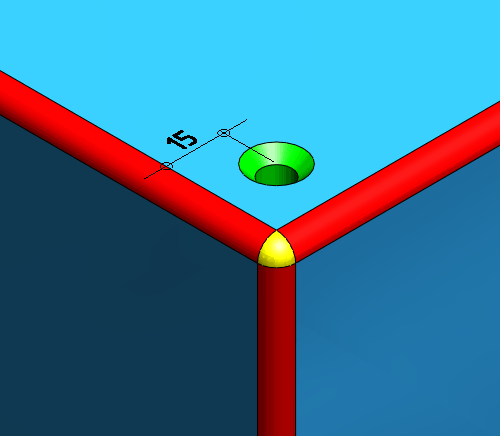LGS 3D v.3.0 takes a major step towards full-scale variational direct modeling – technology that creates design intent by combining the simplicity of history-free geometric editing with the power of constraints
LEDAS Ltd., the independent provider of end-user variational design tools, technology components, and software development services for the CAD/CAM/CAE/PDM market, today announced the availability of version 3.0 of its LGS 3D geometric constraint solver. This core technology component of parametric modeling allows assembly design, motion simulation, and history-free geometric editing. LGS 3D permits users to express their design intent through a combination of geometric constraints and driving dimensions.
Version 3.0 contains many improvements in stability and performance; as well, it implements new features requested by developers of history-free 3D geometry editing applications.

“We developed LGS 3D v.3.0 in close cooperation with our customers,” explains Dmitry Ushakov, Director of Product Management, LEDAS Ltd. ”We detected significant interest from many CAD, CAM and CAE vendors in our variational direct modeling technology, and we plan to extend its scope with several successive versions of LGS 3D to be released this year and next.”
New Features in LGS 3D
Version 3.0’s primary new feature is its ability to adjust the radii of circles, cylinders, and spheres automatically to satisfy constraints. This function allows users to modify fillets, blends, and round holes in their models parametrically. By default, the radii are fixed so that existing assembly design and kinematic simulation applications implemented with previous versions of LGS 3D continue to work as expected.
Version 3.0 also contains significant improvements for the support of periodic curves and surfaces, improvements that were based on testing by customers and their dynamic scenarios.
The algorithms that handle over-defined constraint diagnostics and move-under constraints have been tuned using feedback from customers. The behavior of LGS 3D in solving planar angles is now more natural.
Additional improvements to LGS 3D 3.0 include extended API error diagnostics, corrected journaling mechanisms, and bug fixes. For the full list of changes, please visit the release status page at ledas.com/products/lgs3d/release_status
Version 3.0 of LGS 3D is already embedded in several commercial applications, including a recent release of the RhinoDirect plug-in for McNeel & Associates’ Rhinoceros 3D modeling software. RhinoDirect, as a part of the Driving Dimensions product line, aims at making advanced mechanical CAD technology available to all users of popular 3D software at an affordable price. For more information, please visit www.DrivingDimensions.com
About LGS Software
Since the first commercial release in 2004, the LGS 2D/3D software components have been licensed by a dozen CAD/CAM/CAE vendors, who have embedded it into their applications successfully.
The LGS 2D and 3D geometric constraint solvers are used as parametric engines for 2D sketching and drawing, history-free 3D modeling, assembly design, motion analysis, and other geometric modeling applications. LGS 2D and 3D are cross-platform software packages running on 32- and 64-bit versions of Windows, Linux, Mac OS X, *BSD, AIX, HP-UX, and other operating systems. Coded in C++, LGS 2D and 3D have a C-style API for easy integration into a broad range of software applications using a variety of wrappers, such as .NET, Java, and C++.
LGS 2D/3D supports the creation and modification of geometric models by means of explicit or implicit constraints. Geometric objects include points, lines, circles, planes, cylinders, spheres, parametric curves, surfaces, and swept surfaces. Objects can be fixed in the absolute coordinate system or relative to one other. Supported geometric constraints include logical constraints between geometric entities (coincidence, parallelism, tangency, and so on), and dimensional constraints that specify the required values for distances, angles, or radii. LGS 2D/3D moves and rotates objects to positions that satisfy all constraints, yet minimizes transformations from initial configurations. Other LGS functions implement advanced features of CAD/CAM/CAE systems, such as diagnostics of over- and under-defined parts of models, engineering variables and equations, help points, and tolerance management.
Example applications named “Lege’n’d 2D/3D” are available as free downloads from the LEDAS Web site. These representative samples are of different kinds of 2D sketches and 3D assemblies. The applications can be used to test the functionality, robustness, and performance of LGS 2D/3D. The sample applications were created with the Open CASCADE open-source application framework; the source code is available to all licensees.
To learn more about LGS 2D/3D, visit the LEDAS Web site at ledas.com/products/lgs3d
About LEDAS
LEDAS Ltd. is an independent software development company founded in 1999. It is based at the Novosibirsk Scientific Centre in Akademgorodok, the Siberian Branch of the Russian Academy of Science. A leader in constraint-based technologies, LEDAS is a well-known provider of computational software components for PLM (Product Lifecycle Management) solutions: geometric constraint solvers for CAD/CAM/CAE, optimization engines for project management, work scheduling and meeting planning as well as interval technologies for knowledge-based engineering and collaborative design.
The company also provides services for PLM markets, including software development, consulting, reselling, education, and training. More information about LEDAS is available at www.ledas.com.
LGS and Driving Dimensions are trademarks of LEDAS Ltd. Any other trademarks are the property of their respective owners.
Press Contact
LEDAS Marketing Departmentphone: +7 383 3356 504 / fax: +7 383 3356 256
e-mail: info@ledas.com
www.ledas.com